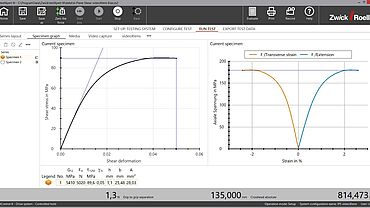Optical Strain Measurement for Composites Testing
An extensometer for everything: from determination of the tensile modulus and Poisson’s ratio to specimen break, and for testing at ambient temperature as well as in a temperature chamber. With the videoXtens biax 2-150 HP ZwickRoell introduces an optical extensometer that was specifically developed for testing of fiber-reinforced composites and can measure without the need for added markings. During development of the videoXtens biax 2-150 HP, the main focus was on customer needs and requirements. Three important points were key. High accuracy in the determination of the tensile modulus and Poisson’s ratio, which is also guaranteed for tests under temperature. A wide range of applications to cover a large number of tests with just one extensometer. And last but not least, minimal effort in specimen preparation.
Determination of the tensile modulus and Poisson’s ratio
The most important criterion for accuracy of the non-contact videoXtens is the fulfillment of the high ISO 527 requirements on the determination of the tensile modulus and Poisson’s ratio. In particular the transverse contraction constant (Poisson’s ratio) can be determined with an unprecedented accuracy for optical extensometers. The videoXtens biax 2-150 HP also meets these requirements for testing in a temperature chamber. A significant win: since the same measuring system can be used both under temperature and at ambient temperature without changes to the hardware, reproducible test results are guaranteed.
Wide range of applications for fiber-reinforced composites
An additional distinguishing advantage of the testing system is the number of applications for fiber-reinforced composites. These include tensile tests to ISO 527-4/-5, ASTM D3039, ASTM D4018, as well as determination of the shear modulus or shear strain to ISO 14129 and ASTM D5318. 3- and 4-point flexure tests to DIN EN ISO 14125 can also be performed without hardware expansions or extensometer conversion.
From the elastic range all the way to break, the videoXtens records the complete stress-strain behavior of the specimen with the highest level of accuracy. There is no risk of damage, since the strain measurement is contact-free. This is an important feature, especially for fiber-reinforced composites with their partially high energy specimen failure.
Minimal effort in specimen preparation
The effort required for specimen preparation is minimal for this extensometer, since gauge marks are not needed. The use of blue contrast lighting greatly enhances the contrast of the natural surface structure of opaque fiber-reinforced composites such as carbon fiber reinforced plastics (CFRP). Virtual gauge marks can be defined with the clearly distinguishable pattern. Therefore, manual specimen markings are not necessary. Of course it is also possible to measure with alternative measuring options on the specimen.
At a glance:
- The videoXtens biax 2-150 HP is a unique optical strain measurement system, which determines the tensile modulus and Poisson’s ratio to ISO 527 with an accuracy never before achieved by non-contact extensometers.
- This accuracy is also attained at temperature inside a temperature chamber.
- Many typical tests on fiber-reinforced composites are covered with a single testing system.
- Strain measurement on non-transparent fiber composites without the need for markings saves significant time and costs.
